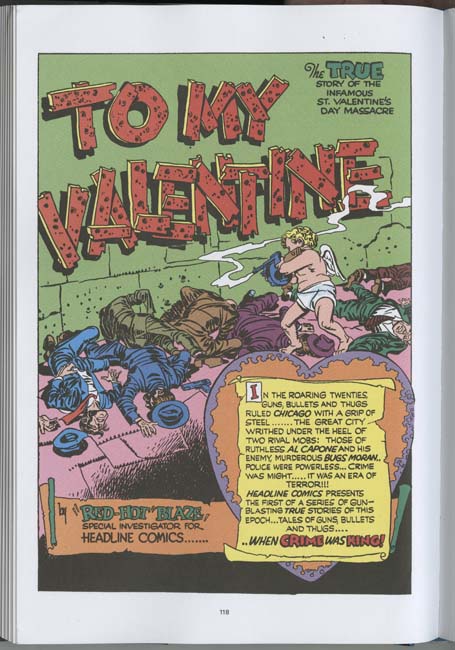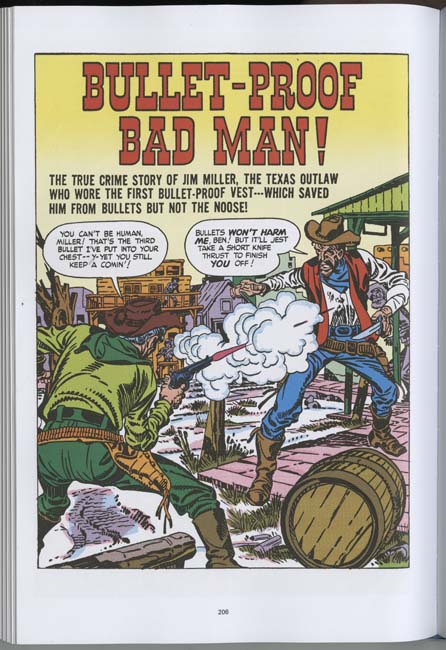There is a new addition to the Simon and Kirby Blog sidebar. The button is not for donations to this blog but for a special project, a Jack Kirby Pop-up Museum. There is a link that provides further explanation on what this project is all about but I would like to make a few comments. Comic books have had a significant impact on our culture. And nobody had more of an impact on comic books than Jack Kirby. Despite the success of some big budget movies based on comic book characters, often ones that he co-created, the public remains largely ignorant of Kirby and his contributions. Jack deserves a permanent museum but that is a probably too ambitious a goal for right now. But a “pop-up” museum is a very realistic objective, with sufficient help. A Jack Kirby Museum open to the public for a period of a few months would attract a lot of attention and also provide the opportunity for an unprecedented display of Kirby art. So please support this effort with generous contributions.
In the Beginning, Chapter 3, Blue Bolt #3
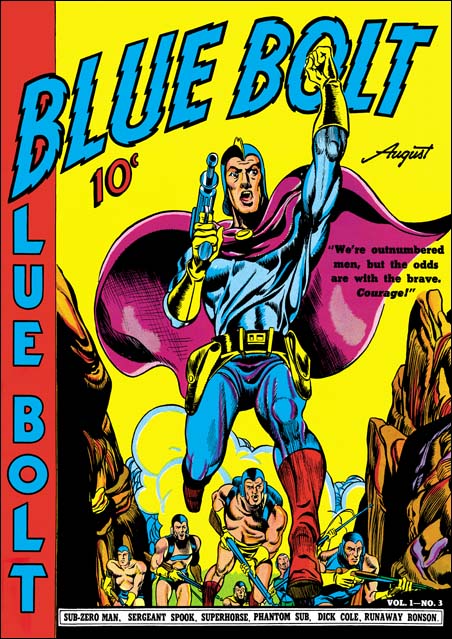
Blue Bolt #3 (August 1940) pencils and inks by Joe Simon
Although Simon and Kirby did 10 issues of Blue Bolt, they only provided 2 covers. The cover for Blue Bolt #3 is based on a panel from the story that also was done by Joe and it in turn was a swipe from Flash Gordon by Alex Raymond (Art by Joe Simon, Chapter 4, Footnote). But none of them could be described as close copies. For the cover Simon takes an extremely low view point so that we can see the sole of his boot. The men that Blue Bolt is leading appear to be coming over a ridge through a narrow pass.
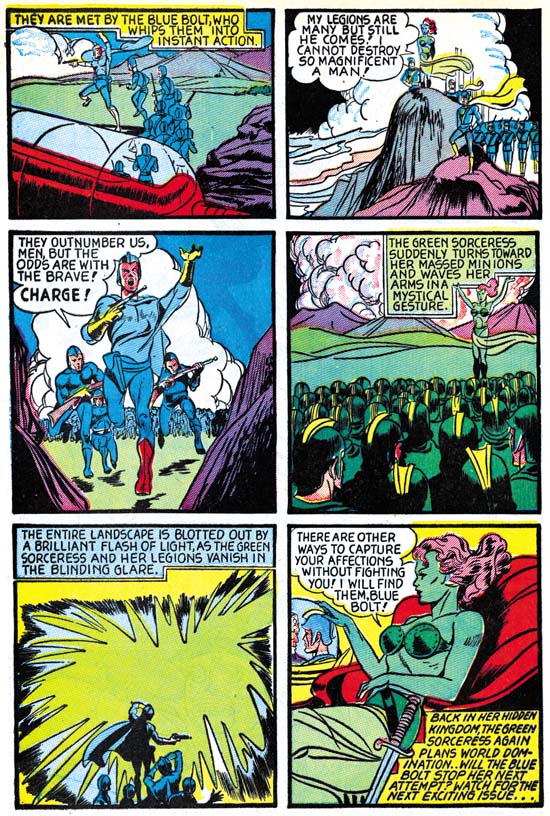
Blue Bolt #3 (August 1940) page 10, pencils and inks by Joe Simon
The same Blue Bolt figure appears in panel 3 of page 10. The view point is a little higher than on the cover but still rather low. The background figures are not the same and in the story we can see the soldiers as they advance over a plain. But the story panel still has the narrow pass.
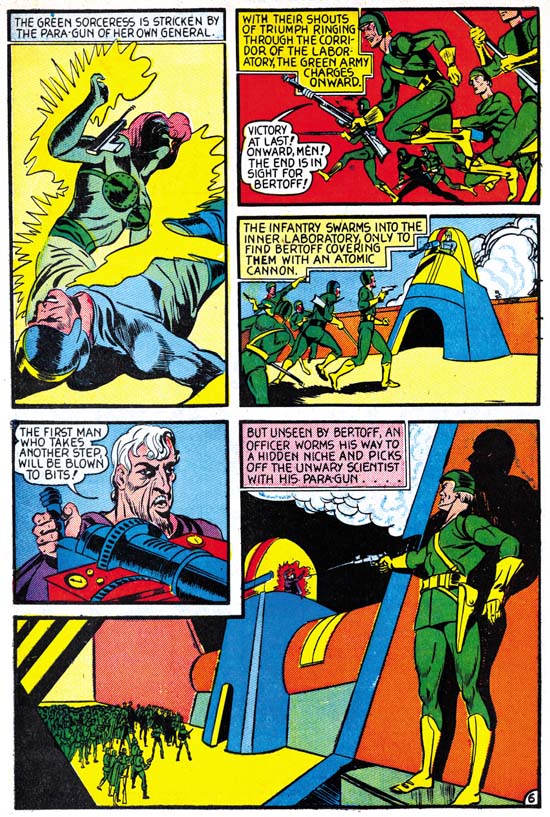
Blue Bolt #3 (August 1940) page 6, pencils and inks by Joe Simon
Most of the panels on page 10 are distant views which make it harder to see how far Joe’s art has advanced. Page 6 provides closer views allowing that better show his artistic improvement. Simon’s work had already been steadily improving but working with Kirby probably helped.
There is a regular improvement as well in the quality of the writing in the first three issues of Blue Bolt. Actually the story for BB #3 is greatly advanced over BB #2. Was this due to Joe learning as he went? Or is it possible that the script was written by someone else? I doubt if Kirby had anything to do with the improvement as his contribution to BB #3 seems so small (see below). In the future most stories would be written by others after which Joe and Jack would rewrite them to give their stories the special Simon and Kirby quality.
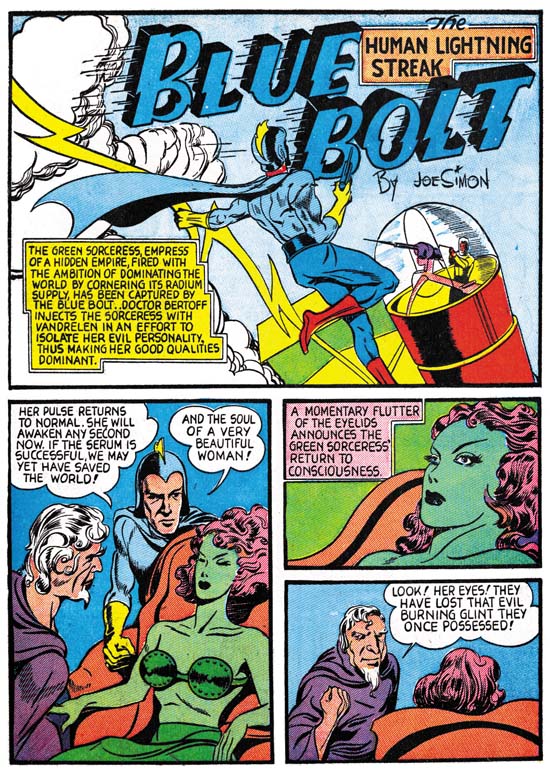
Blue Bolt #3 (August 1940) page 1, pencils by Jack Kirby, inks by Joe Simon
Although the splash panel credits Joe Simon alone, Jack Kirby drew the first page and two other (pages 2 and 7). Whatever their working arrangement was it seems clear that it was not the full partnership that would exist later. Kirby provides even fewer pages for Blue Bolt #3 that he had for BB #2. While Kirby inked his own pages for BB #2 it was Simon that inked Kirby’s pages for BB #3. So Kirby’s contribution had actually diminished.
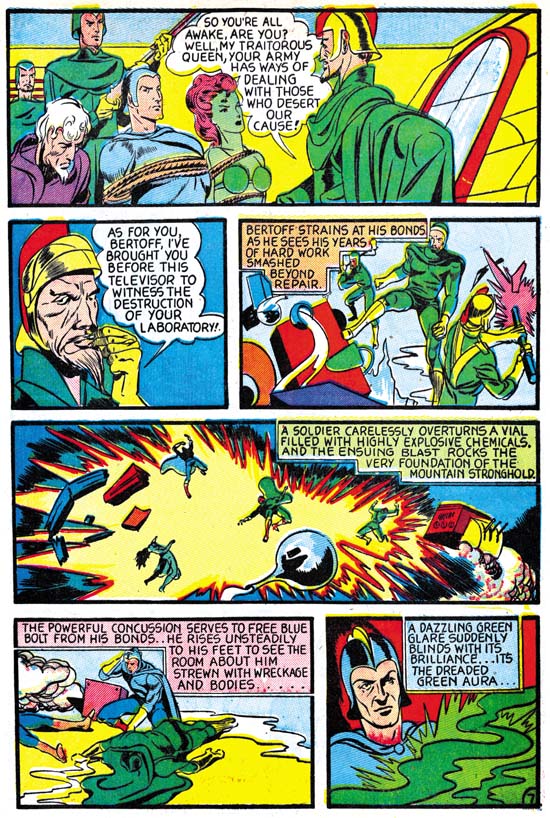
Blue Bolt #3 (August 1940) page 7, pencils by Jack Kirby, inks by Joe Simon
Joe Simon became quite good at inking Jack Kirby’s pencils. So good that it is often difficult to determine who providing the inking. But for BB #3 Joe’s hand is revealed by his handling of eyes and eyebrows which are merged into one angular form. In the previous chapter I suggested someone other than Joe or Jack inked the cover to Champion #9 (July 1940). Now seeing pages from BB #3 like the one shown above I realize that cover was in fact inked by Simon. Note the smooth and stylized folds on the clothing which are like those found on the Champion #9 cover.
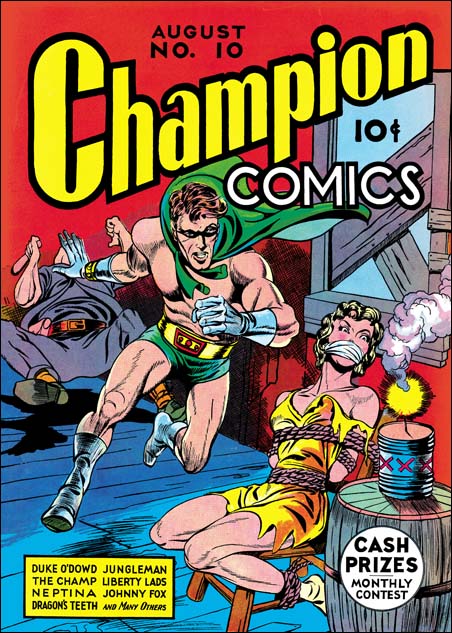
Champion #10 (August 1940) pencils by Jack Kirby, inks by Joe Simon
While there is disagreement on what credits should be applied to the art for the covers of Champion #8 (June 1940) and #9 (July 1940) it is pretty much agreed that Kirby drew the Champion #10 cover. Jack is already showing some of his typical traits such as the hero’s unruly hair, the use of exaggerated perspective and a running stride that is more impressive than realistic.
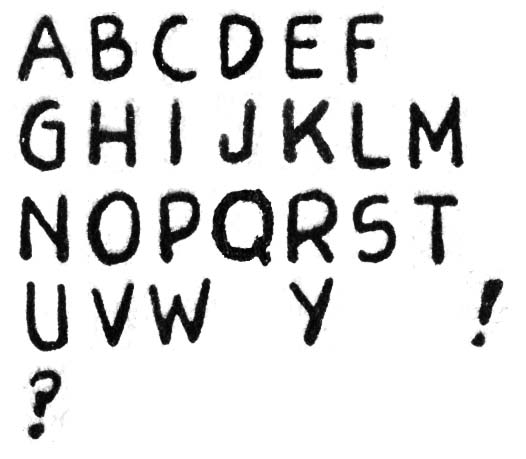
Blue Bolt #3 (August 1940) letters by unidentified letter
The lettering for Blue Bolt #3 is different from that of BB #1 (by Joe Simon) or BB #2 (by an unidentified letterer). Absent from BB #3 are Simon’s rather unique ‘W’, Kirby’s special horseshoe shaped ‘U’ or BB #2 letterer’s unusual ‘E’. The BB #3 letterer uses a special ‘G’ with a long straight segment that pushes the horizontal bar to a great height. The angular ‘J’ is also unusual but that is not a commonly used letter. Other letters to note are the ‘W’ and ‘M’ where the inner angle does not extend as far as the outer leg segments. Further the ‘M’ has vertical outer lines.

Prize Comics #7 (December 1940) “The Black Owl” letters by Howard Ferguson
Some have suggested that Howard Ferguson did the lettering for BB #3. The timing is certainly possible because at that time Joe Simon had left Fox to become Timely’s first editor where Howard Ferguson was working. I have discussed Ferguson’s lettering (Some Lettering by Howard Ferguson) and I include above an example of his work from just a few months later. They do not look like the same letterer to me. Note the very different forms for the letters ‘C’, ‘G’, ‘J’, ‘K’, ‘M’, and ‘W’. Some have argued that at Ferguson had just begun to do lettering at this time and his work was not initially as professional as it would be later. The suggestion has been made that the unusual double line border to the captions found in BB #3 (see above images) is a Ferguson trademark. However as we will see in a future chapter Ferguson was not the only one using this special caption border.
When I started this serial post my intentions were to concentrate on Blue Bolt using it to show the beginnings of the Simon and Kirby collaboration. However I find myself referring more and more to sources outside of that title to clarify what is going on. So I have decided to make this a serial post on the early stages of the Simon and Kirby team up with Blue Bolt as just one of the comics included in the discussion. My new plan is to examine Simon and Kirby up to the creation of Captain America. The first two chapters have been re-titled accordingly but otherwise remain unchanged.
My Advance Copy of Simon and Kirby Library: Crime
I am thrilled to say that I have received an advance copy of “Simon and Kirby Library: Crime”. This is the second book in the Library series and it matches the size of the previous Superheroes volume. Well not completely matches but with 320 pages the Crime book is still an impressively sized book. For those readers that have not seen the Superheroes book, the Library books are 7 3/4 by 11 1/4 inches in dimension. This allows the comic art to be reproduced at slightly larger than their original dimensions for enhanced readability.
I love everything that Simon and Kirby produced but I do have some favorites. While superheroes are popular and were a logical choice to start the Library, it is not my favorite genre. What I love above all others are Simon and Kirby’s work on crime and romance which makes this volume very special for me. I think it will be special for many readers as well. Simon and Kirby were masters at making interesting comics but with crime they had a natural source for excitement and action. And boy did they take advantage of it. Simon and Kirby worked on crime comics for two relatively short periods but put together an impressive amount of work. This book brings together 315 pages of what has been described as the best of Simon and Kirby crime. I am not sure that “best of” is completely accurate. Joe and Jack did such a great job on the crime genre that I do not think it is possible to pick the best ones. There is only one crime story (not included in this volume) that I feel was not up to par for Simon and Kirby (and I suspect there would be many fans that would say my opinion of that story is wrong). However much effort was made to provide this book with a lot of variety in the stories. This volume contains a little less than half the Simon and Kirby crime so that if it sells well enough the rest of the material could be collected into a second volume. I am not saying that is the plan but I have no doubts that it could happen.
I am very proud of the Simon and Kirby books that Titan has published. However I have to admit that certain things came out better in the proofs than in the actual printed books. Now some publishers might have just blamed the printer or said that good was good enough but Titan took a different approach. Instead each book has been examined to determine what could be done to make the next one even better. This approach has really paid off. I am truly please with the crime volume and I am sure the readers will be as well.
Amazon lists the book as being released on October 25 but it is likely to appear in some stores earlier than that. “The Simon & Kirby Library: Crime” will be sold by Titan at the upcoming New York Comic Con. Joe Simon will be doing a panel on his autobiography at 3:45 on Friday. Joe rarely makes public appearances anymore so this is something special. I suspect that afterwards he may be doing a book signing.
In the Beginning, Chapter #2, Blue Bolt #2
Blue Bolt #2
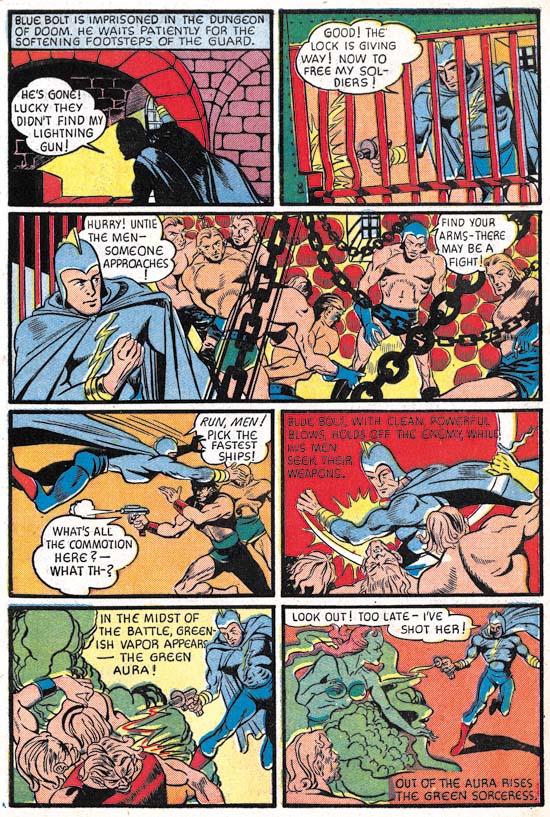
Blue Bolt #2 (July 1940) page 9, pencils and inks by Joe Simon
The story art for Blue Bolt #2 looks rather different from that from its predecessor. One reason for this is that (as mentioned in the previous chapter) the first issue was created earlier then the cover date would suggest. While Blue Bolt was drawn earlier it really was not that much earlier, probably just a matter of a few months. The difference between Simon’s art for the two stories show how rapidly he was adapting to working on comic books. The figure art has improved as well as what can be best described as his ability to graphically tell a story. There also appears to be a greater use of design. For example the interesting architecture in the first panel. Even better examples can be found in the long third panel. The wall is built with round stones giving an overall pattern to the background. Frankly this was not so successful as it gives the image a rather cluttered look. More effective are the chains which besides reflect on the imprisonment of Blue Bolt’s men add interest to the panel without disturbing what is important to the story. The chains are inked as silhouettes which removes them of the third dimension but emphasizes their function as a design element.
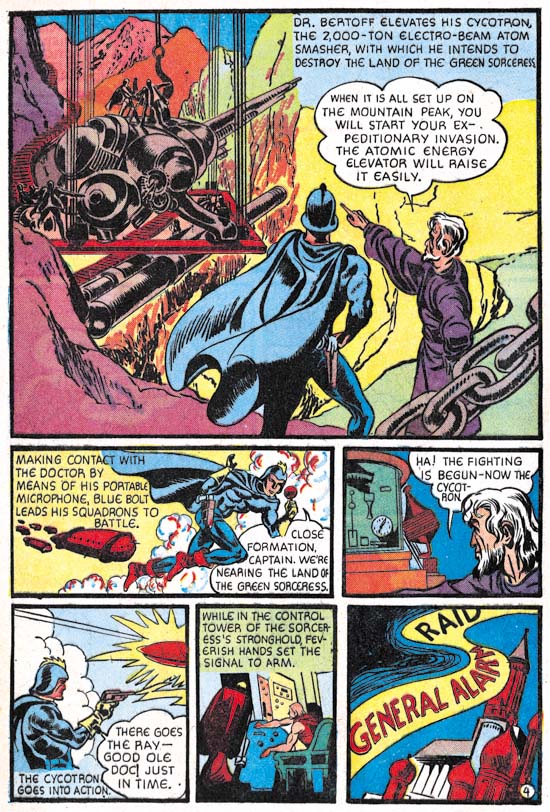
Blue Bolt #2 (July 1940) page 4, pencils and inks by Jack Kirby
The other reason that the art for Blue Bolt #2 looks so different from that in #1 is that some of it was created by Jack Kirby although only Joe Simon was given credit in the splash. In the future Kirby would be the primary penciller of Simon and Kirby productions but that was not the case here. Simon created 6 1/3 of the pages while Kirby only did 3 2/3 pages. Fractions are used in these counts because on the first page Joe did the splash while Jack did the story art. The precise tally is that Simon did pages 1 (splash only), 3 and 6 through 10 while Kirby did pages 1 (story only), 2, 4 and 5. Each artist inked his own pencils.
Note that Kirby introduces a foreground chain in the first splash-like panel but to very different effect. Here the chain is not so much a design element as a means of adding depth to the image. The chain is also carefully inked to provide it with a full dimensionality that is very different from the flat silhouettes that Simon used.
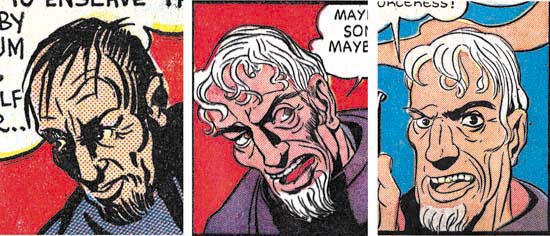
Blue Bolt #1, art by Joe Simon
Blue Bolt #2, page 10, panel 7, art by Joe Simon
Blue Bolt #2, page 1, panel 2, art by Jack Kirby
It is interesting to compare Simon’s artistic progress from Blue Bolt #1 to #2 as well as Kirby’s efforts from issue #2. I have chosen close-up of Dr. Bertoff to provide these comparisons. In BB #1 and much of BB #2 Simon portrays Dr. Bertoff as a rather “ratty” looking individual. A surprising unflattering depiction of a scientific genius. However Dr. Bertoff gets better treatment in some of Simon’s BB #2 art. Now part of this improvement can be credited to Joe’s rapid advancements as a comic book artist. However comparing Simon’s best depiction of Dr. Bertoff with that by Kirby suggests that Joe was also being influenced by Jack. Kirby was never very good at adopting other comic book artists styles but that was something that Simon was very adept at. During this time Joe was doing the cover art for the Fox Comics successfully mimicking Lou Fine. Now Joe was trying to copy Jack’s style. This was desirable because it would give stories produced by Simon and Kirby a unified look. At this early time Simon only achieved limited success at mimicking Kirby but he would greatly improve in the future.
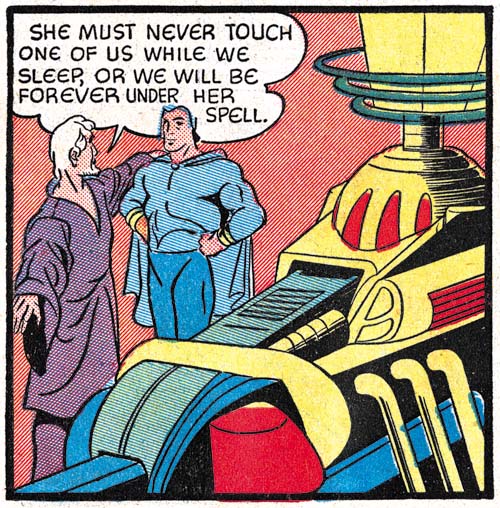
Blue Bolt #2 (July 1940) page 3 panel 5, pencils and inks by Joe Simon
Kirby drew impressive machinery throughout his career. This can be seen even at this early stage in his career as for example the “electro-beam atom smasher” from the splash-like first panel of page 4 shown earlier. Jack did similarly impressive devices on every page of this Blue Bolt story that he drew. Machinery appeared on some of the pages that Simon did but generally more distant views less rich in details. Even in the few close-ups that Joe provided (such as the example from page 5 provided above) his versions were no match for Kirby’s more interesting depictions. It is not clear whether Kirby was given those pages to draw because they would contain such machinery or that Jack inserted such fantastic devices whenever he could.
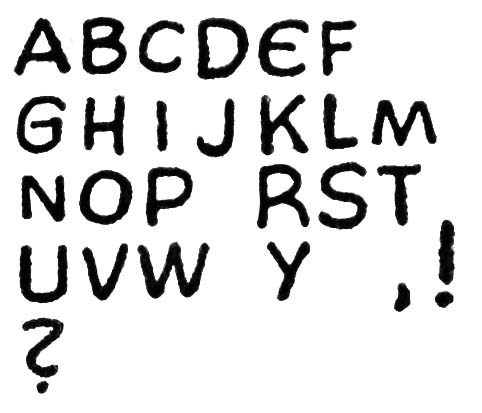
Blue Bolt #2 (July 1940) story letters by unidentified letterer
From past work that Joe Simon and Jack Kirby did it might be expected that either they would letter the pages that they drew or the lettering would be done by one of them. But neither of these likely possibilities was the case. Both Joe and Jack had very distinctive lettering styles (see Early Lettering by Joe Simon and Jack Kirby as a Letterer). But nowhere in Blue Bolt #2 can be found the unique lettering such as Joe’s ‘W’ or Jack’s ‘U’. Instead the story has one rather remarkable ‘E’, shaped like a ‘C’ with a bisected with a short horizontal stroke. I have never seen either Joe or Jack use anything quite like it. Joe’s lettering would improve in years to come and some of his more eccentric traits would become more conservative. In particular his peculiar ‘W’ would become more standardized. So while it is possible that Joe might have temporarily stopped using his more unusual ‘W’ and adopted an equally unique ‘E’ the rest of the lettering still do not look like Simon’s. The BB #2 letters seem rather squat and blocking compared to Joe’s. The ‘R’ often exhibit a curved right leg however when Joe curved that same leg it he curved it in the opposite direction. As for Kirby not only does the Blue Bolt #2 lack Jack’s horseshoe shaped ‘U’ but the manner of writing ‘K’ is also different between the two. My conclusion is that just like Simon brought Jack in to help with the art, he brought in someone else to do the lettering.
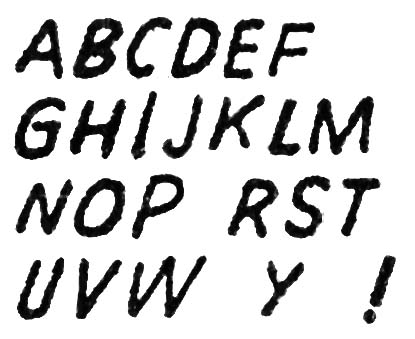
Blue Bolt #2 (July 1940) splash letters by unidentified letterer
The lettering in the splash looks different from the story lettering. Of course much of this is due to the fact that the splash lettering is slanted while in the story the letters are all very vertical. But the splash lettering also looks less squat and uses a more standard form for the ‘E’ and ‘R’ letters. There is one exception found on the last panel on page 8 where the tilted splash lettering is used for a single word. The switch in lettering could have been done to put more emphasis on the word (nowhere in the story does the letterer use the common technique of employing bold lettering to provide emphasis). But it is also possible that the tilted lettering was added later to correct some problem with the original script or lettering. Without the original art it is hard to be sure. My suspicion is that all the lettering, including the splash, was done by one individual. The main piece of evidence to support this is the form of the letter ‘G’ common to both where there is a straight vertical or near vertical segment attached to the horizontal stroke.
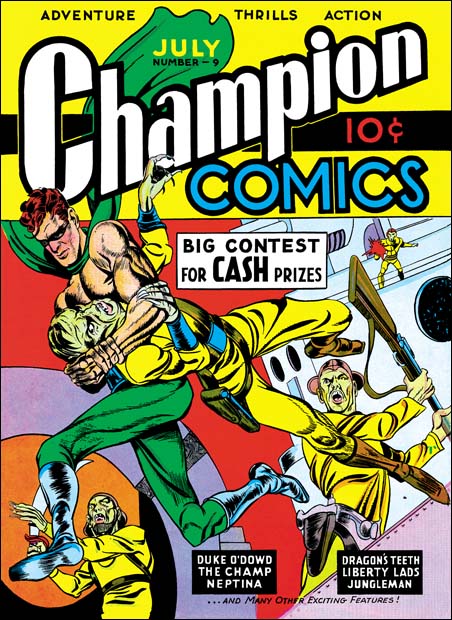
Champion Comics #9 (July 1940) art by Joe Simon and Jack Kirby
Champion Comics #9 came out the same month as Blue Bolt #2. It featured cover art that should be credited to Joe Simon and Jack Kirby. As I mentioned in the previous chapter of this serial post (Blue Bolt #1) I suspect that the Champion #8 (June 1940) cover was the first joint work by Simon and Kirby but I admit not everyone may favor that opinion. Most agree that Champion #9 was a Simon and Kirby production. It appears that Kirby was involved in at least some, if not most, of the penciling. Some have pointed out the way the sole of the runner’s foot is turned to the viewer and have credited this as a Kirby trait. However both Joe and Jack would use this device in the future. As far as I know this is the earliest occurrence of the peculiar technique and therefore it cannot be used to distinguish between the two artists. For it to be used an earlier example would have to be found used by one but not the other artist and to date I have not seen one. While the figure art has a Kirby appearance it is not completely typical of Kirby. I attribute that to Simon’s involvement in the art. The form lines on the runner’s boots look like the work of Simon but much of the rest of the inking does not look like either Joe’s or Jack’s work. So I suspect a third artist may have been involved in the inking.
Some Early Jack Kirby Techno Art
Things did not work out as planned and I am unable to provide this weeks post as I intended. Rather than just skip a week I thought I would provide some examples of early Kirby techno art.
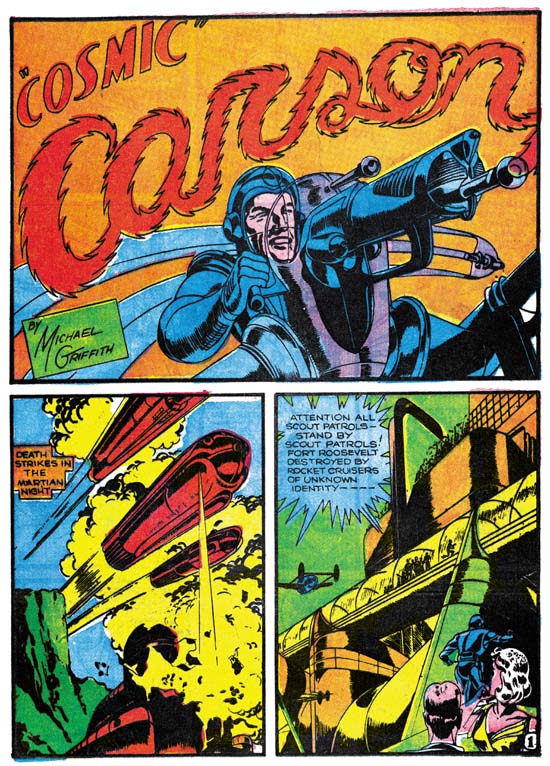
Science #4 (May 1940) “Cosmic Carson”, pencils and inks by Jack Kirby
Kirby’s early work was for syndication although some were repackaged into comic books. The syndication format and the subjects that Kirby worked on were not conducive for displays of advance technology. But when Kirby started to do actual comic book art much of it was science fiction and techno art quickly made its appearance. Where did Jack get his inspiration for this work? I have not seen any earlier comic books by other artists that was anything near as impressive. The special effects from early science fiction movies were really not that great. Perhaps Kirby’s inspiration was from art used in pulps but unfortunately that is an area that I am largely unfamiliar.
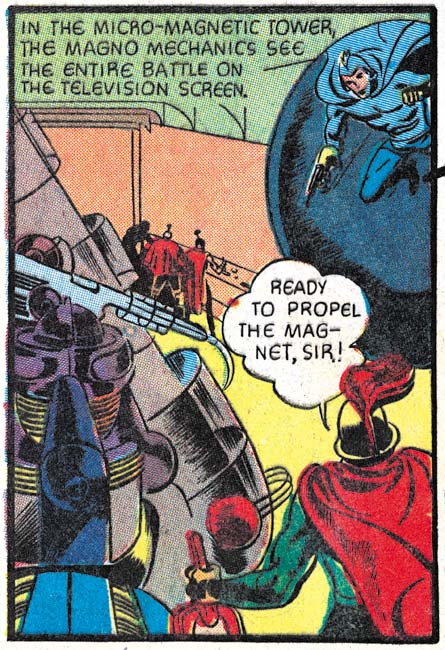
Blue Bolt #2 (July 1940) “Blue Bolt” page 5 panel 4, pencils and inks by Jack Kirby
When Kirby began helping Joe Simon with Blue Bolt he began to use an abundance of techno art. Another example of techno art from Blue Bolt #2 should be seen in next week’s post.
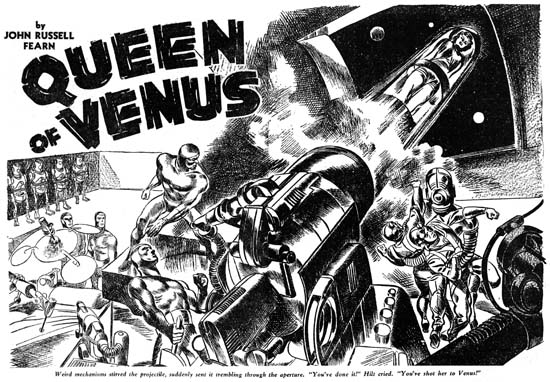
Marvel Stories v. 2, n. 2 (November 1940) “Queen of Venus”, art by Jack Kirby
Larger Image
Kirby also did some pulp work and techno art made its appearance there as well. Pulp art is interesting because generally it is not inked like comic books were. Instead it generally was drawn on special paper that had a special surface that would break pencil markings into dots suitable for reproduction. Kirby may not have been very comfortable with this process and he often used his pencils very much like he would a brush so that grey tones were neglected and instead the art is built up with crosshatching.
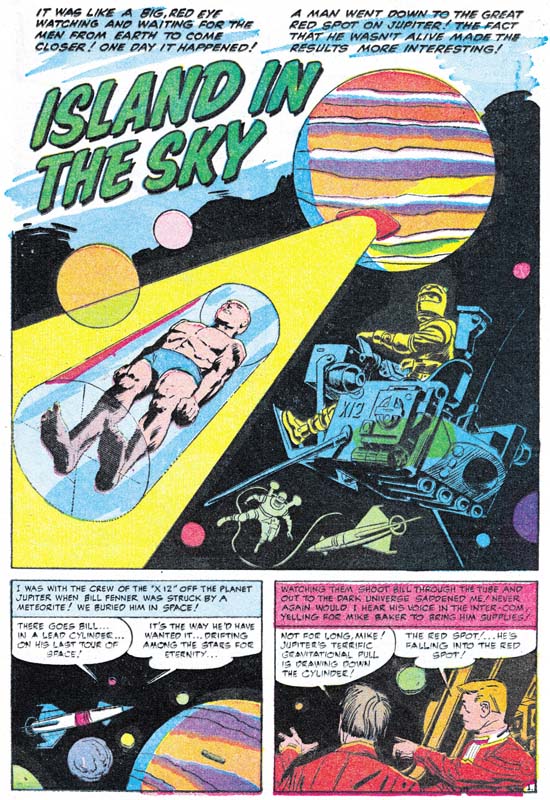
Race to the Moon #2 (September 1958) “Island in the Sky”, pencils by Jack Kirby
Most of the work that Simon and Kirby did was in genre that simply would not call for the use of techno art. There was one story in Fighting American with a science fiction slant but for whatever reasons it has no examples of real techno art. There was not much in the way of techno art even when Simon and Kirby returned to science fiction in the short lived but marvelous Race to the Moon. The best would be various space transport vehicles but even these seem weak in comparison with what Kirby did previously.
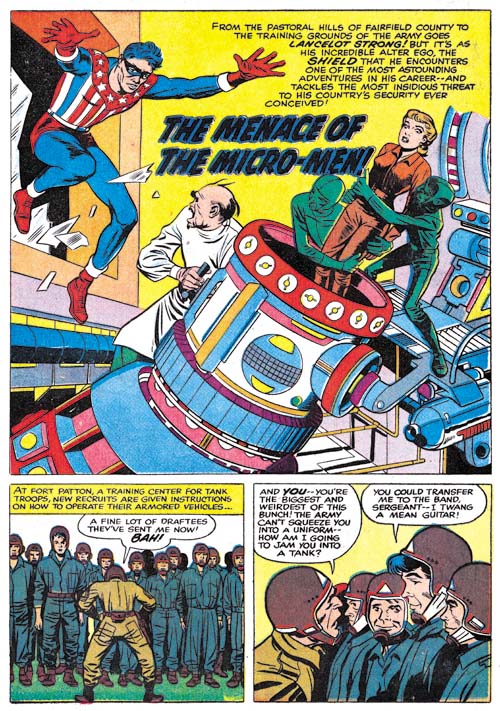
Double Life of Private Strong #1 (June 1959) “The Menace of the Micro-Men”, pencils by Jack Kirby
But Jack had not abandoned techno art. It appears again in final work that he did with Joe Simon. In a few years later Kirby’s use of techno art would blossom in comics like the Fantastic Four. But that is a topic I will leave for others to pursue.
Remembering 9/11
I do not believe there will be another 9/11 light memorial, so I will not have a photograph to accompany this post. Another anniversary has arrived and in many ways little has changed. For me 9/11 is still a day of quite contemplation. Nothing can bring back the victims of this tragedy and so all we can do is try to honor their memory. But in other respects much has changed. A new building is rapidly rising on the World Trade site. More importantly one of the chief perpetrators of this tragedy has met his fate. I do not consider myself a violent person and normally I do not rejoice at the death of people I do not like. But Osama bin Laden was America’s mortal enemy seeking to take more innocent lives. I am quite pleased that he is not around on this anniversary.
In the Beginning, Chapter #1, Blue Bolt #1
I have decided to do a serial post on the first ten issues of Blue Bolt (June 1940 to March 1941). It was during this feature that the Simon and Kirby collaboration first developed. There were other comics that Joe and Jack worked on during the start of their partnership but that work was done a piece here and a piece there. However Blue Bolt was a monthly feature allowing us to examine Simon and Kirby learning to work together. But I will use this opportunity to discuss some of the other early work that the two did together or individually during that period.
The first issue of Blue Bolt is cover dated June 1940*. At that time Simon was editor for Fox Comics having started in May. Jack Kirby was also working for Fox primarily on the Blue Beetle syndication strip. Kirby previous experience had also been in syndication strips (although some ended up published in comic books) but in May Jack did some comic book art for Fox as well as moonlighting elsewhere. It surely is no coincidence that Kirby provided stories for Fox during the same month that Simon began as editor. It is even possible that Joe encouraged or even helped Jack to find work moonlighting outside of Fox as that happened at the same time.
Joe Simon had spent about seven years working as a staff artist for newspapers before entering the comic book field. His earliest published comic books were “The Fantastic Thriller of the Walking Corpses” (the Fiery Mask story for Daring Mystery #1), “Solar Patrol” and cover for Silver Streak #2 and another cover for Keen Detective Funnies #17 all cover dated January 1940. However the publication dates for Joe’s early work did not reflect very well the order that the art was actually created. Simon’s earliest comic book work appears to have been the western “Ranch Dude” but that did not appear until Amazing Man #10 from March. Joe was supplying this early work to Funnies Incorporated a shop run by Lloyd Jacquet who apparently held on to some of the stories before finding a use for them. Something similar happened to the first Blue Bolt story but for a special reason. Although Simon supplied it with no more special thought than any of the other art he did, Jacquet recognized the potential for using it for launching a new comic book title. This was quite a coup especially for someone so new to the comic book industry as Joe was. It is uncertain when the art for first Blue Bolt story was actually created but judging from the style I would say it was quite early. Of course not as early as “Ranch Dude” but not too long afterwards.
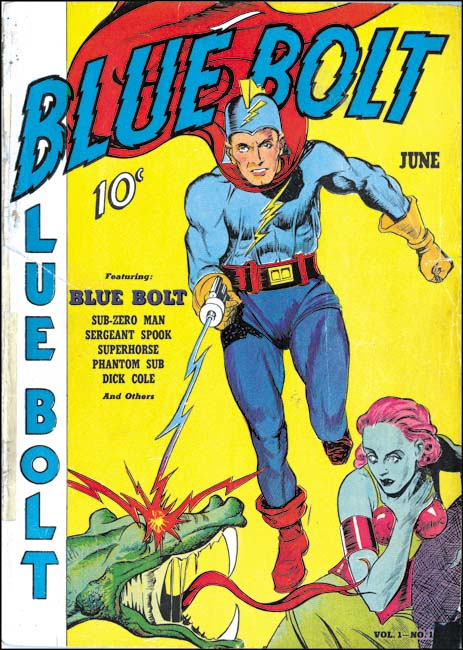
Blue Bolt #1 (June 1940), art by an unidentified artist
Since Simon had no idea about Jacquet’s intentions of using the first Blue Bolt story as the main feature of a new title, he would not have supplied cover art with the story but of course theoretically Joe could have supplied it later. Some have credit Simon for the cover art but I disagree. The style does not seem quite right to me compared to work that Simon is known to have done at that time. Further the dragons in the story have beaks while the one from the cover has a mouth more like an alligator.
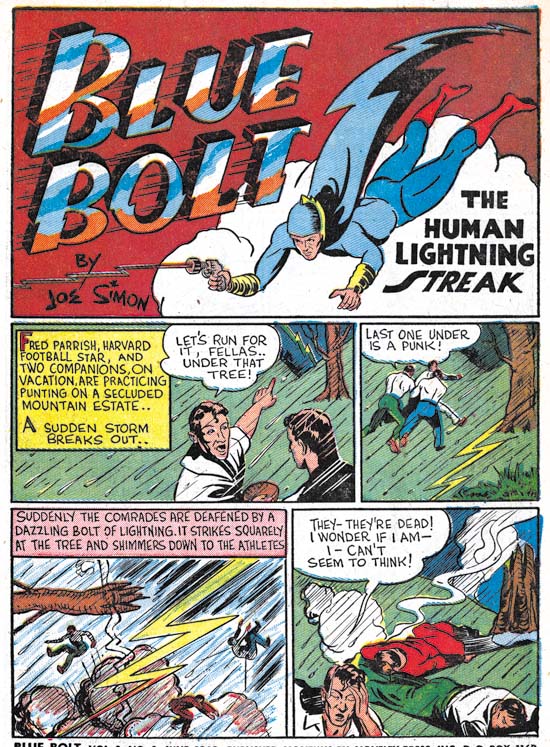
Blue Bolt #1 (June 1940), pencils, inks, script and lettering by Joe Simon
Joe Simon not only penciled the story but he inked and lettered it as well. I remember when the reprint books on Fletcher Hanks came out the introduction remarked that one of the things that made that artist special was that he did all penciling, inking and lettering the story himself. Actually that was not so unusual during the comic book industry’s earlier years. Joe provided all the art except coloring on most of his early works. That is not to say Simon was equally proficient in all aspects of the art. While unconventional and interesting, I would not describe Simon’s lettering as very good. Even today Joe feels his lettering never became truly professional. The lettering for Blue Bolt #1 is in his initial style, examples of which can be seen in my post Early Lettering by Joe Simon. Two aspects of the lettering that may seem unusual to modern readers are the use of borderless captions and the placing of some captions at the bottom of the panel. Joe was a fan of Hal Foster who used low and borderless captions in his Prince Valiant syndication strip.
The art itself is somewhat primitive. While Simon was an accomplished newspaper staff his previous work did not include sequential story telling. Further his newspaper work had been either realistic or cartoonish while comic books required something in between. So it is not surprising that Joe’s earlier art was a bit rough and the story a little weak. This was earlier in the history of comic books and the industry employed many artists whose work was not even as good as Simon’s initial efforts. We can be critical of Simon’s early work knowing what was to come but it should be remembered that the Blue Bolt character and the first story that went with it was good enough for a publisher to release a new title based on it. Something that never happened for most comic book artists and Joe’s time in the business then could be measured in months. Joe learned fast and by the time that Blue Bolt #1 was released he had already been doing covers for Fox Comics that in the past had been attributed to Lou Fine until his small signatures were found (Art by Joe Simon, Chapter 3, Working for the Fox). Even at this stage Simon was better than most comic book artists working in the industry.
One of characteristics of Joe’s early work was one that stayed with him throughout his career, his frequent use of swiping. Some of the swipes come from Prince Valiant (by Hal Foster), Flash Gordon (by Alex Raymond) and pulp art. There may have been other sources as well since some images occur multiple times in Simon’s art but the source of the swipes has not been identified. This topic has been discussed more thoroughly in the serial post Art by Joe Simon. Further discussion of Blue Bolt #1 can be found in Chapter 4, Transition.
 Champion Comics #8 (June 1940) art by Joe Simon and Jack Kirby?
Champion Comics #8 (June 1940) art by Joe Simon and Jack Kirby?
The covers that Simon did for Fox Comics were not the only art that came out the same month as Blue Bolt #1. I have long been puzzled by the correct attributions for the cover art of Champion Comics #8 (June 1940). The art has generally been credited to Joe Simon and in the past that had been my opinion as well. But Joe had certainly met Jack Kirby by this time. The background architecture uses an unusual and varied perspective that can be found in a number of the Fox covers that Simon did but does not occur in any of Kirby’s solo efforts. The figure art is different than that found on the covers that Joe did for Fox Comics. But that is not surprising because Joe was purposely mimicking Lou Fine for Fox in order to provide continuity with the earlier covers now that Fox was no longer using Eisner and Iger to produce the comic art. Not only would Simon not have to mimic Fine for the Champion #8 cover but since it was for a different publisher it would actually be undesirable to do so. Unfortunately there are no earlier cover art by Jack Kirby to compare with Champion #8. There is something Kirby-ish about the figure art but Joe could have picked that up having seen Jack’s work. Kirby would become famous for his slugfests but the hero’s advisory falls back from the punch in a rather stiff and awkward manner that seems hard to accept as something Jack would do even at this early stage in his career.
One rather intriguing aspect of this cover is the elaborate gun. Kirby had a long history of drawing interesting and elaborate machinery. A fanciful gun also appears in the splash for Cosmic Carson story for Science Comics #4 (May 1940, see Early Jack Kirby, Chapter 2, Working for Fox). It has been suggested that the gun from Champion #8 was swiped by Simon from that Cosmic Carson splash. However it is not a close copy and the two guns are quite different. Unlike Kirby, Simon does not have a history of drawing elaborate devices. We shall in future chapters that when machinery appears in Blue Bolt it is Jack, not Joe, that provides it. It is hard for me to accept that Kirby did not have something to do with gun from Champion #8. While I still give Joe Simon most of the credit for the Champion #8 cover I now feel Jack Kirby was involved in some capacity as well. This is important because if I am right than the cover for Champion #8 would be the earliest Simon and Kirby collaboration.
footnotes:
* Like most of my posts, I am going to be using cover dates. True calendar dates for the release of the comic would be about two months earlier and for the creation of the art five or six months earlier except in special cases like Blue Bolt #1 were the art was not used for some time.
Evolution of Kirby Krackle

Fantastic Four #57 (December 1966) “Enter, Dr. Doom” page 5 panel 4, pencils by Jack Kirby, inks by Joe Sinnott (from the Marvel Omnibus)
In the 60’s Jack Kirby began to draw clusters of round black dots to depict enormous but not necessarily directed energy, often of a cosmic nature. This simple graphic technique was so effective that it has been picked up by other comic book artists and can still be found in comics of today. The device has been given the name Kirby Krackle. It is an annoying cute* name but one that has become so entrenched that I feel that it must be accepted.
But what are the origins of Kirby Krackle? Some comic book scholars have pointed to a panel from Fantastic Four #46 (January 1966) where the Inhuman Triton is depicted in water surrounded by bubbles and black shapes that look surprisingly like Kirby Krackle. Nothing to suggest energy or anything cosmic but visually similar enough that perhaps it formed the basis for an imaginative leap by Kirby. Old grainy photographs of Quasars (astronomical objects discovered in 1963) have also been suggested to be the inspiration for Kirby Krackle. Because at the time inkers were encourage to embellish the pencils some have even suggested that it was the inker Joe Sinnott that actually created Kirby Krackle!
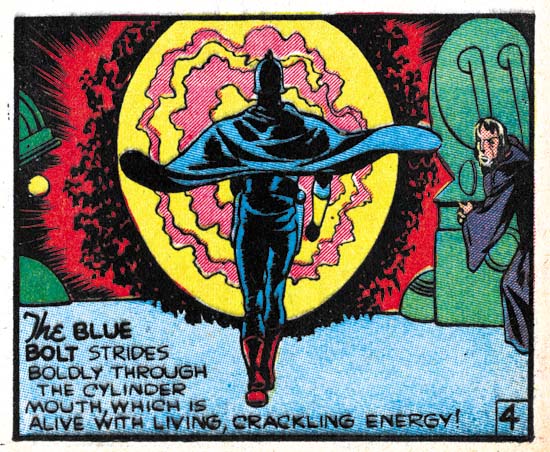
Blue Bolt #5 (October 1940) last panel of page 4, pencils by Jack Kirby, inks by Joe Simon
Such explanations for the origin of Kirby Krackle were all reasonable but those who presented them overlooked Jack Kirby’s long career. Jack had a long memory and old ideas would reappear many years later. There is no better example than Kirby Krackle. The first appearance of Kirby Krackle appears to be found in Blue Bolt #5 (October 1940)**. This really is likely to be the earliest example of Kirby Krackle. Kirby did some previous science fiction stories on his own but nothing resembling Kirby Krackle appears in them. Nor did it appear in Simon’s earlier science fiction nor in the previous issues of Blue Bolt. It is unclear who to credit with this device as Kirby did the pencils and Simon the inking. Unfinished art from later in the Simon and Kirby collaboration shows that while Kirby’s pencils were pretty tight they were line art only with all spotting left to the discretion of the inker. However this example of Kirby Krackle is from early in the Simon and Kirby partnership (which started with Blue Bolt #2, July 1940). This is so early in their collaboration that is would seem reckless to make any assumptions on what were their working methods at that time.
In some respects this is a perfectly acceptable example of Kirby Krackle. But it is not yet the perfected form. While the massing of particles is very much like typical Kirby Krackle the particles are not round but irregular, often angular, in shape. However it is clear that this early example shares the same intent as the caption describes it as having “crackling energy”.
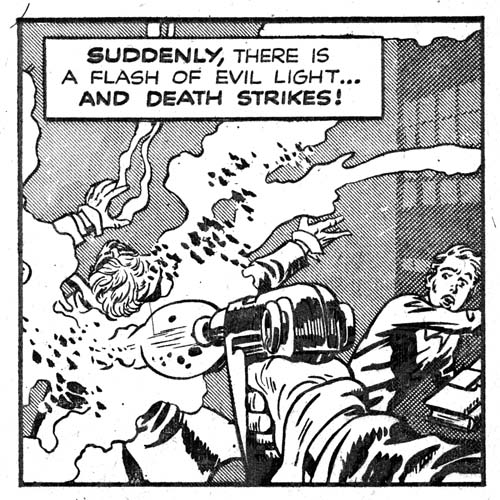
Captain 3-D #1 (December 1953) “The Man from the World of D”, page 2 panel 6, pencils by Jack Kirby, inks by Joe Simon
Simon and Kirby did not do much science fiction and it would be years before something very much like Kirby Krackle made its appearance once again. In 1953 Simon and Kirby put together Captain 3-D for Harvey Comics. It was a rush job to try to take advantage of the 3D craze. All the pencils were by Jack Kirby but the inking was done by an assortment of artists which besides Jack and Joe included Mort Meskin and Steve Ditko (for a more complete examination of the inking see Captain 3D). In the origin story, “The Man from the World of D”, a villains uses a special weapon which releases energy outside the actual firing path. The weapon from the Captain 3D story has a cosmic connection as it is described as a gamma ray gun. In some ways this is not as close an example to Kirby Krackle as that found in Blue Bolt perhaps because of the difference between a dimensional doorway and a weapon. The particles are not clumped together as well as in the Blue Bolt example but have become less irregular in shape. While some have become more rounded other particles still are rather angular.
There is good evidence from unfinished art that by this period Kirby’s pencils provided outlines only with only simple lines to indicate things like the folds in the clothing. How the spotting was to be done was left to the inker. Most of this page was inked by Steve Ditko but Joe Simon applied a lot of retouching. While it is difficult to say with any certainty who to should be credited with the inking of the Kirby Krackle the similarity with the next example suggests it was likely Simon who applied the it.

Captain 3-D #1 (December 1953) “The Man from the World of D”, page 3 panel 6, pencils by Jack Kirby, inks by Joe Simon
The futuristic gun appears once again in the next page from “The Man from the World of D”. The arrangement of the particles is very much the same as the previous example but the particles themselves have lost any angularity and become more rounded. They would not however be described as truly circular in shape. This page was inked by just Joe Simon and so he was likely the one to supply the Krackle.
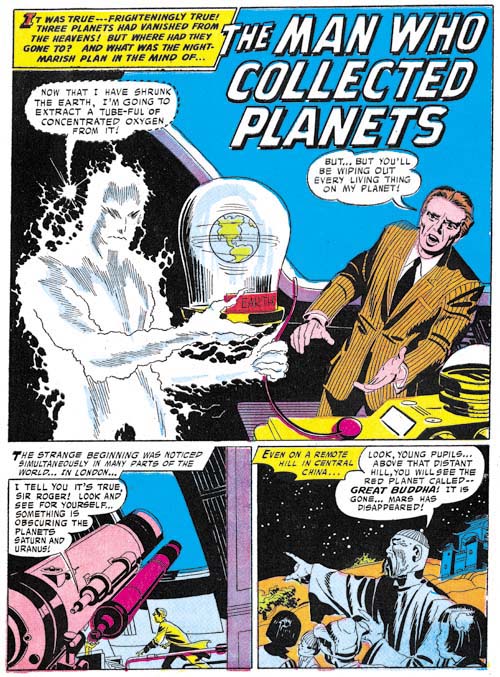
Tales of the Unexpected #18 (October 1957) “The Man Who Collected Planets”, pencils and inks by Jack Kirby
Once again the use of anything akin to Kirby Krackle does not appear for some time largely because there were few if any stories where it might be appropriate. After the Simon and Kirby partnership ended Jack began to do freelance work mostly for DC. Something akin to Kirby Krackle appears in the depiction of the alien in a story called “The Man Who Collected Planets”***. While the alien is surrounded by something not dissimilar to Kirby Krackle it covers an uncharacteristically narrow area and the primary purpose appears to be more of a means of providing him with a fiery aura than of suggesting a form of energy.
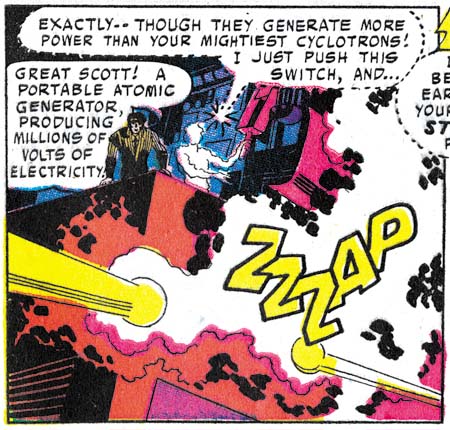
Tales of the Unexpected #18 (October 1957) “The Man Who Collected Planets” page 3 panel 5, pencils and inks by Jack Kirby
However “The Man Who Collected Planets” contains panels that show something very much closer to true Kirby Krackle than that used in drawing of the alien. Here it truly is energy that is being depicted. The particles have become more varied in size a more clumped together. However unlike typical Kirby Krackle the particles are still not very rounded in shape.
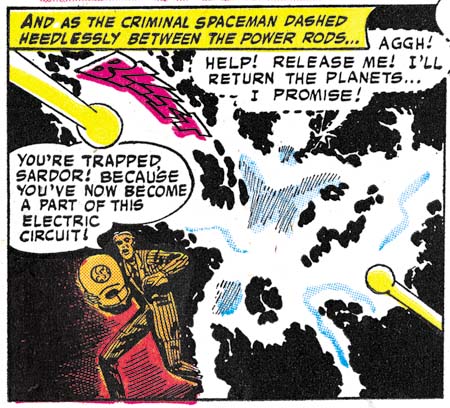
Tales of the Unexpected #18 (October 1957) “The Man Who Collected Planets” page 5 panel 5, pencils and inks by Jack Kirby
This was no accident as the same Kirby Krackle precursor appears elsewhere in the story. Kirby did his own inking for most of the horror or science fiction stories that he did for DC. “The Man Who Collected Planets” is a great example of Kirby inking Kirby. So in this case we can safely give Kirby the credit for this Kirby Krackle prototype.

House of Mystery #84 (March 1959) “The Negative Man”, panel from page 3, pencils by Jack Kirby, inks by Marvin Stein?
Further examples of a Kirby Krackle prototype appear in another story that Kirby drew for DC, “The Negative Man”. This story is again about an unearthly being and something similar to Kirby Krackle is used to provide the being with a fiery aura. But once again it is elsewhere where even better examples of Kirby Krackle can be found such as the energy wake left behind the negative man of one panel from the third page.
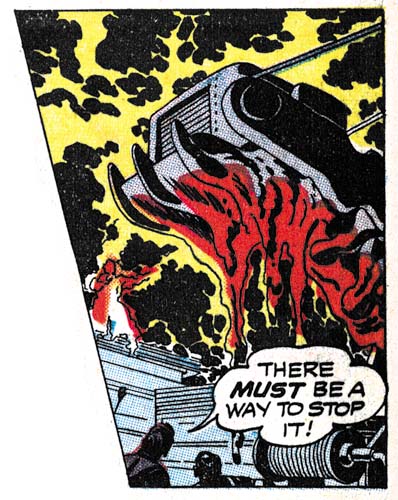
House of Mystery #84 (March 1959) “The Negative Man”, panel from page 5, pencils by Jack Kirby, inks by Marvin Stein?
An even better example of Kirby Krackle prototype is found in small panel from page 5 where the negative man unleashes his power. The particles are relatively large and not at all circular but the clumping is very much like typical Krackle.
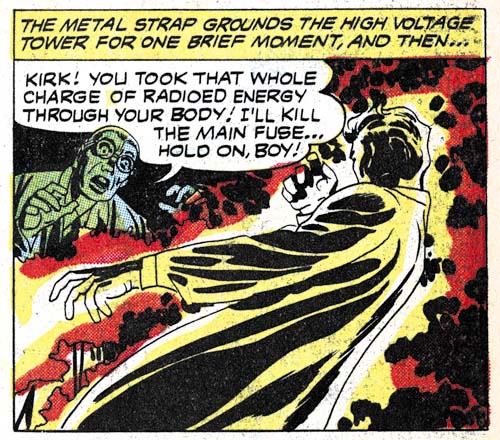
House of Mystery #84 (March 1959) “The Negative Man”, panel from page 2, pencils by Jack Kirby, inks by Marvin Stein?
The Kirby Krackle prototype from “The Negative Man” is very similar to that found previously in “The Man Who Collected Planets”. However while Kirby inked his own pencils in the earlier story some other artist inked “The Negative Man”. I am not positive as to who that inker was but the blunt but fluid brushwork looks very much like the work of Marvin Stein so I questionably attribute it to him. The two stories are similar enough that perhaps Stein used the earlier Kirby inked story as a reference when inking this one. Or perhaps Kirby had already begun to include how a story should be spotted in his pencils. In either case the use of the Kirby Krackle in this story should be credited to Jack Kirby.

Fantastic Four #49 (April 1966) “If This Be Doomsday” page 12, pencils by Jack Kirby, inks by Joe Sinnott (from the Marvel Omnibus)
While the infrequent use of Kirby Krackle in the earlier publications can be explained by the lack of appropriate stories, its absence from Kirby’s earlier silver age work for Marvel is more difficult to understand. There certainly were a number of stories with subjects seemingly well suited for Kirby Krackle. It would seem that Jack had just forgotten about it. Perhaps there is some truth in the explanations previously used to explain the emergence of Kirby Krackle but not as inspiration for its creation but rather as a reminder to the artist of an almost forgotten technique. Once true Kirby Krackle appeared it was already exhibited the classic clumping of round particles and in this respect it differs from the earlier prototypic versions. Not perfect circles but not the more extended shape of the prototypes.
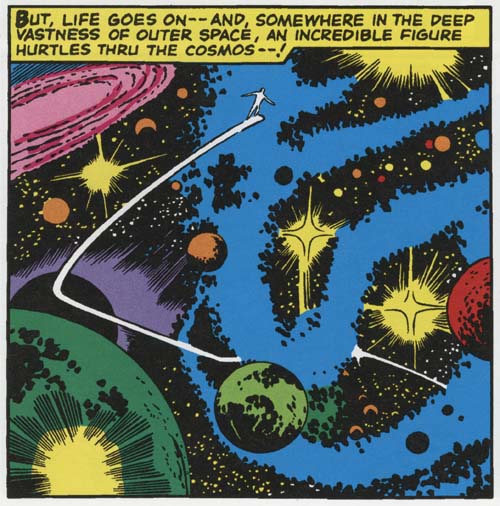
Fantastic Four #48 (March 1966) “The Coming of Galactus” page 12, pencils by Jack Kirby, inks by Joe Sinnott (from the Marvel Omnibus)
While classic Kirby Krackle was used to portray a simmering energy, the same purpose the prototypic form had been put to, Jack also used it when depicting the cosmos. Kirby Krackle always seem to have a cosmic connection but had not previously been used when drawing outer space. I suspect Kirby was using this device to suggest that space was more than vast distances of vacuum but a place filled with potent energy. Certainly with the help of Kirby Krackle, Jack’s astronomical visas became more exciting than any other comic book artists had ever achieved.
P.S.
I have previously written about Kirby Krackle but I have decided to gather it all together with some new information. I will provide links to my previous posts but the reader will find little more than what is covered here (Kirby Krackle, More Kirby Krackle). Shane Foley has written an excellent article available online exploring the appearance of Kirby Krackle in the Marvel comics (Kracklin’ Kirby, Jack Kirby Collector #33). While he understandably failed to make the connection with previous examples of Kirby Krackle, his article does a marvelous job of tracing its use in silver age comics.
Footnotes:
* The overuse of Kirby K… is so extensive that my reaction is to wonder whether the originators of these terms were more interesting in getting credit for coining a cute name than in any serious investigation into Jack Kirby’s artistry.
** I do not know who to credit for first trying to draw attention to this early example of Kirby Krackle. It was brought up on the now defunct Kirby List where the poster provided a page number based on the Verotik Blue Bolt book. Unfortunately that volume lacks paging and the image that at the time I thought was being referenced was not an example of Kirby Krackle. I came across the panel from Blue Bolt #5 during a recent review in preparation for a serial post I hope to do on Blue Bolt. I am sure it is that panel that the Kirby list poster was trying to refer to.
*** The use of Kirby Krackle in “The Man Who Collected Planets” was originally pointed out to me by Ger Apeldoorn in the comments to one of my early posts on Kirby Krackle.
Happy Birthday Jack Kirby
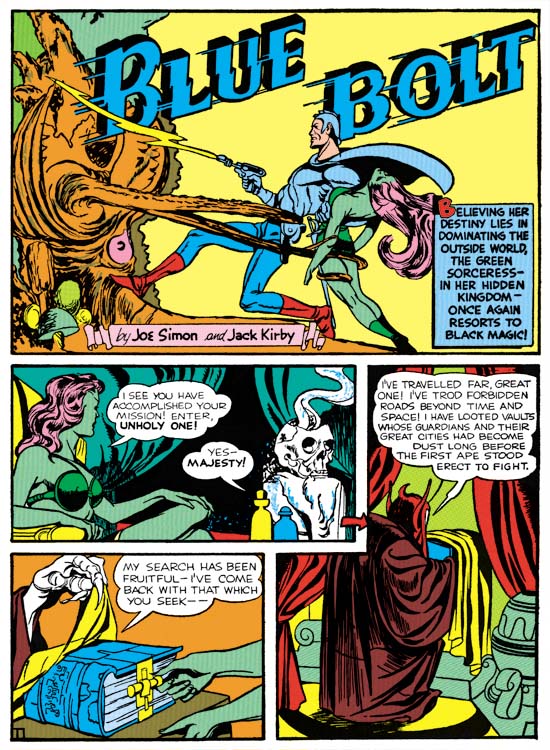
Blue Bolt #5 (October 1940) pencils by Jack Kirby, inks by Joe Simon (the first use of the Simon and Kirby credits)
I am pretty busy but not too busy to acknowledge Jack Kirby’s birthday. After all he is half of what this blog is dedicated to. While it is his collaboration with Joe Simon that commands my greatest attention, Jack had a long career that included work with Stan Lee and on his own. Any one of these periods would be enough to insure Kirby’s placement among the foremost comic book artists but all together make him nothing less than Kirby, King of Comics.
Police Trap #6
Police Trap #5 (July 1955) was the first issue published by Charlton. It appears to be composed largely of work that was already in the work at the time of the sudden failure of Simon and Kirby’s own publishing company, Mainline. It would expected most of that work would be used up and Police Trap #6 would consists of newly created work. All of the work on issue #6 was drawn by Jack Kirby. Previously Kirby’s involvement was largely limited to providing covers with the only Kirby story appearing in Police Trap #5. Jack’s greater presence can be explained as a means of offsetting recent financial loses. The cost of creating the Mainline comics was covered by Simon and Kirby to be paid back by a share of the profits. However with the sudden demise of Leader News Joe and Jack would not get the money to recover their publication costs. Their incomes from Prize Comics were based on a share of the profits but with all the negative public criticism against comic books those royalties were probably down as well. By providing all the art for Police Trap #6, Kirby probably hoped to decrease the production costs, increase sales (and therefore his share of the profits) but also be paid as the artist as well.
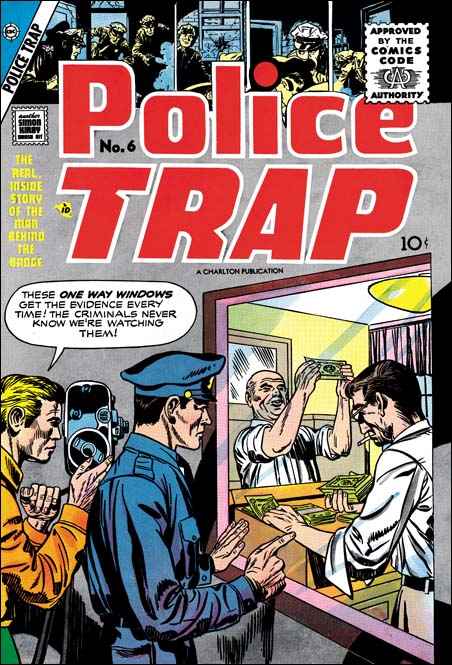
Police Trap #6 (July 1955), pencils by Jack Kirby
The cover of Police Trap #6 is another less than spectacular piece of art. But it is interesting as a rare example of Kirby swiping from another comic book artist, in this case Marvin Stein. This is not a close copy, Kirby did not need any help in how to draw figures. Rather it is the unusual idea that Kirby picked up, that of counterfeiter’s being candidly filmed by the police. I had previously written about this swipe (A Criminal Swipe) where I provided an image of the Stein cover that Kirby swiped. In that post I offered the possibility that it was actually Stein that swiped from Kirby and that this cover was an unused piece left over from Simon and Kirby’s earlier efforts in the crime genre from 1947 to 1951). However I now consider this unlikely as the art for the Police Trap #6 cover does not seem to match
the style used during the earlier period.
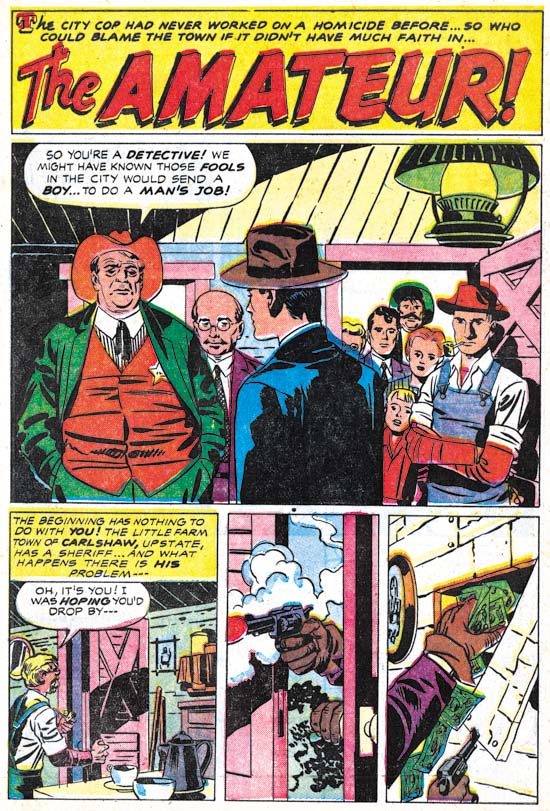
Police Trap #6 (July 1955) “The Amateur”, pencils by Jack Kirby, inks by Mort Meskin
As mentioned above, Jack Kirby drew all the art for this issue which makes Police Trap #6 a special comic. Needless to say the art is all well done. Kirby had a flair for graphically telling a story. Note the short sequence of story panels at the bottom of the splash page. It starts out typically enough but then proceeds to two panels with captions or speech balloons. Text was not required to explain the story and in fact the lack of text makes the panels even more effective.
Police Trap #6 is also special in that all the art was inked by the same artist. I’ll explain why I think this inker was Mort Meskin below where his hand is even more obvious but here I will discuss why I believe it was not either Simon or Kirby that did the inking. Normally that might not be too difficult to determine because both Jack and Joe were much better inkers than many of the other artists they used to ink Kirby’s pencils. Here, however, we have a great inking job. Not only that but it is done in what I describe as the Studio style. On this page (and others in this book) can be found shoulder blots, picket fence crosshatching and abstract arc shadows (see my Inking Glossary for an explanation of the terms I am using). But note that the shoulder blots are not done in a manner typical for Simon and Kirby. They are less abstract and more apt to be broken up into pieces. The most glaring example of this is found in the man in the blue suite. There are other suggestions that this was not inked by either Simon or Kirby. Note the simple eyebrows even in the more close-up views provided in the splash panel.
It is unclear whether some of the typical Studio style techniques were done by the inker or instead were added by either Kirby or Simon afterwards. For example the abstract arc shadow in the first story panel is done in a very typical style. My suspicion is that the original inker provided these touches as well as they are so well integrated with the surrounding artwork. If this is true it is another indication on how well acquainted the inker was with techniques previously used in the now defunct Simon and Kirby studio.
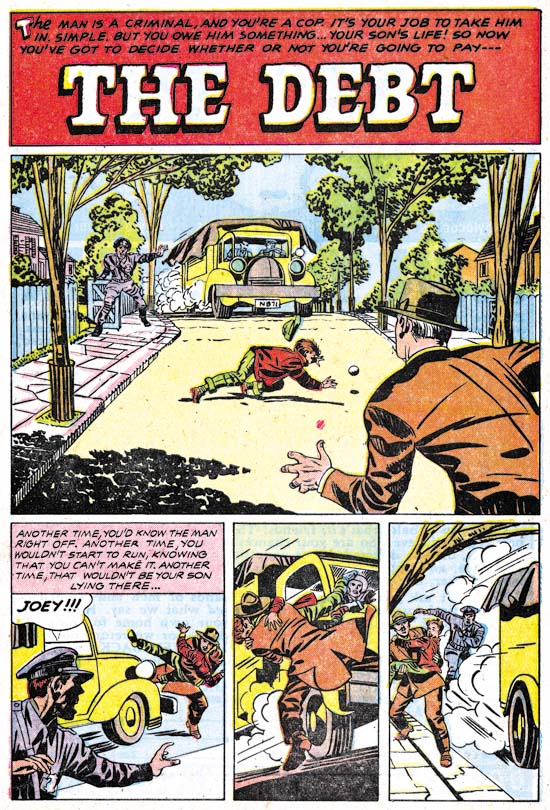
Police Trap #6 (July 1955) “The Debt”, pencils by Jack Kirby, inks by Mort Meskin Albistur
The story panels for the first page of “The Debt” follows the same pattern as seen in “The Amateur”. First an introduction panel that quickly places the reader into the action followed by two panels without text that show how the action unfolded. The big difference between the two stories is that while “The Amateur” has a typical splash the splash found in “The Debt” is actually a story panel as well. While collaborating with Simon, Kirby worked from scripts created by various writers but which he would then customarily rewrite. It is unclear how much of the published story was rewritten but there are often phrases that sound very much like Kirby. But who can say whether the original writer originated these unusual textless story sequences or that Kirby rewrote them into the script.
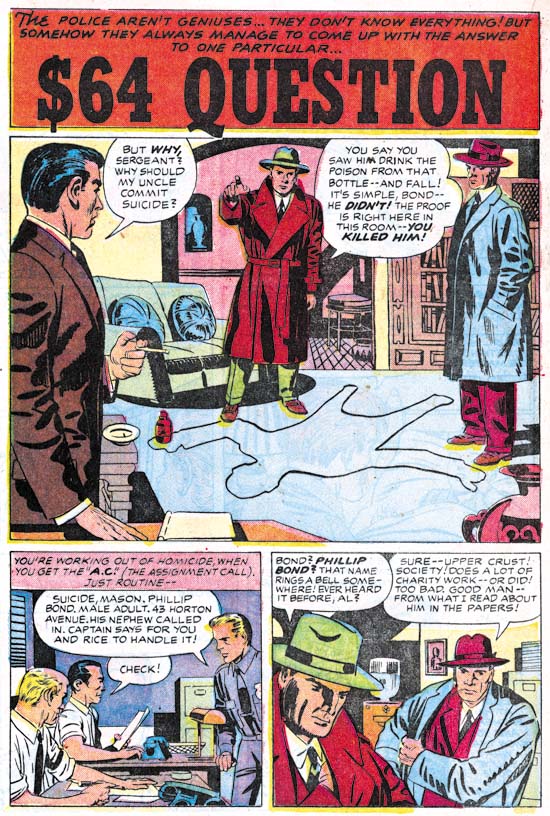
Police Trap #6 (July 1955) “The $64 Question”, pencils by Jack Kirby, inks by Mort Meskin
The $64,000 Question was a popular game show in the 50’s and even today you occasionally here someone use that term a colloquialism for a significant question. However that show first appeared on television in June 1955 much too late to have influenced this story (whose creation start around February of that year). However there was an earlier game show that was on the radio from 1950 to 1952 that was actually called the $64 Question. Although it was off the air when this story was created I am sure that was that show that formed the genesis of this story’s title.
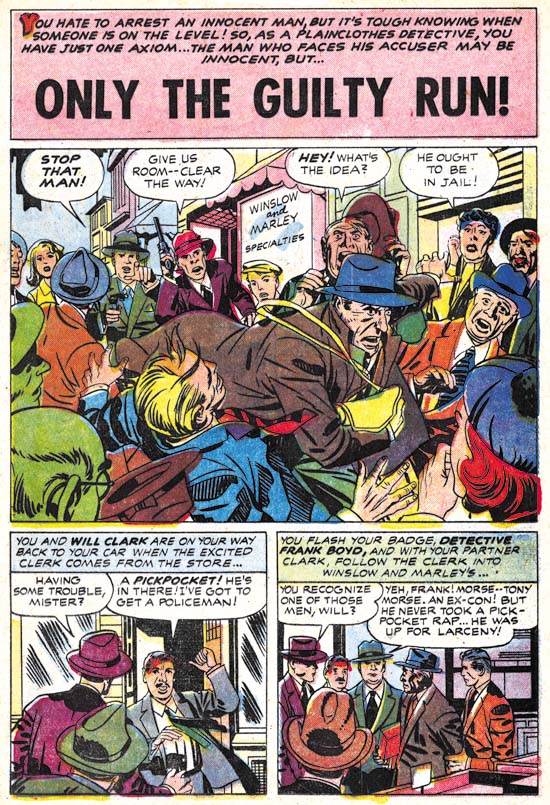
Police Trap #6 (July 1955) “Only The Guilty Run”, pencils by Jack Kirby, inks by Mort Meskin
All the stories in this issue were inked by the same artist. “Only The Guilty Run” is the story that most convincingly shows that this inker was Mort Meskin. Like all the other stories from this issue the inking was done in the Studio style. Most noticeable in the splash is his use of picket fence crosshatching. Of course other inkers used this technique most notably both Kirby and Simon. However Meskin executed picket fence crosshatching with an almost mechanical control compared to the more spontaneous use by Kirby or the more rougher brushwork by Simon. Observe how Meskin’s “rails” and “pickets” are almost consistent in width and the “rails” are placed to almost entirely contain the “pickets”. Other Meskin inking characteristics can be found in the simplified and often angular eyebrows particularly those of the escaping thief in the splash panel. Of course since credits were not provided inking attributions can never be given with absolute certainty but I am as confident as it is possible to be that this inking was by Mort Meskin.
While the art may convince me that Meskin was inking there Kirby pencils I am somewhat puzzled how this came about. While Mort had inked Jack’s work before, generally he was too busy penciling and inking his own work. There were exceptions to this most notably in Boys’ Ranch (1950 to 1951) and Captain 3-D (1953). However in 1954 he had started working for DC. Meskin still did some work for Simon and Kirby but this was largely limited to some covers and nowhere near his prolific output when the S&K studio was going strong. Yet here he is providing a lot of inking for a single issue (plus one Kirby story for the previous issue). Very perplexing.

Police Trap #6 (July 1955) “Third Degree”, pencils by Jack Kirby, inks by Mort Meskin
Despite the Comic Code all the stories from this issue are really quite good but I have to admit that I find “Third Degree” the least satisfying. The interrogation of the housewife by the burly police officer seems a bit forced. Still that story and all the others in this issue leaves one with a desire for another all Kirby crime comic. Unfortunately it was not to be, at least for some years (see Jack Kirby’s “In the Days of the Mob”) and never again with Joe Simon.
P.S.
I have had a comment about why I believe this inker was Mort Meskin and not Marvin Stein. For readers who also wonder about this I suggest checking my previous posts Kirby Inkers, Mort Meskin and Kirby Inkers, Marvin Stein.



